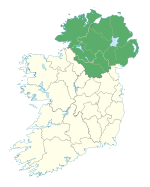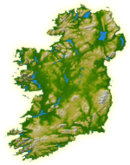Slieve League
| Slieve League | |
|---|---|
| Sliabh Liag | |
 | |
| Highest point | |
| Elevation | 596 m (1,955 ft)[1] |
| Listing | Marilyn |
| Geography | |
| Location | County Donegal, Ireland |
| OSI/OSNI grid | G544784 |
Slieve League or Slieve Liag[1] (Irish: Sliabh Liag, meaning 'mountain of stone pillars')[2] is a mountain on the Atlantic coast of County Donegal, Ireland. At 596 metres (1,955 ft), it has the second-highest sea cliffs in Ireland after Croaghaun,[3] and some of the highest sea cliffs in Europe.
The Belfast naturalist Robert Lloyd Praeger wrote in 1939:
A tall mountain of nearly 2000 feet, precipitous on its northern side, has been devoured by the sea till the southern face forms a precipice likewise, descending on this side right into the Atlantic from the long knife-edge which forms the summit. The traverse of this ridge, the "One Man's Path", is one of the most remarkable walks to be found in Ireland - not actually dangerous, but needing a good head and careful progress on a stormy day....The northern precipice, which drops 1500 feet into the coomb surrounding the Little Lough Agh, harbours the majority of the alpine plants of Slieve League, the most varied group of alpines to be found anywhere in Donegal.[4]

Slieve League is often photographed from a viewpoint known as Bunglass. It can be reached by means of a narrow road that departs from Teelin. The final few kilometers of this route is built along a precipice and includes several places where it turns at the crest of a rise.
Image gallery[]

Slieve League panorama
Slieve League's eastern end
Extended view of the eastern end of Slieve League

One Man's Path

Looking down

Across the top
References[]
| Wikimedia Commons has media related to Slieve League. |
- ^ Marshall, David (2006). Best walks in Ireland. London: Frances Lincoln, p. 139. ISBN 978-0-7112-2420-9.
- ^ "Sliabh Liag/Slieve League". Placenames Database of Ireland.
- ^ Fairbairn, Helen (2014). Ireland's Best Walks. Gill & Macmillan. p. 86.
Just where are Ireland's highest sea cliffs? Two coastal communities claim the bragging rights: Donegal's Slieve League awards itself the accolade, yet mighty Croaghaun on the western tip of Achill Island boasts cliffs that are both higher and marginally steeper.
- ^ Praeger, Robert Lloyd (1997). The way that I went: an Irishman in Ireland. Cork: Collins Press, p. 41. ISBN 978-1-898256-35-9.
- Mountains and hills of County Donegal
- Cliffs of Ireland
- Protected areas of County Donegal
- Gaeltacht places in County Donegal
- Marilyns of Ireland








